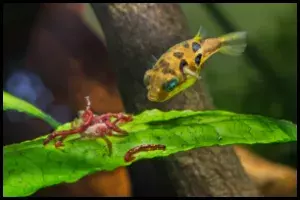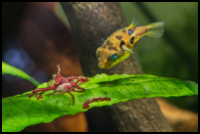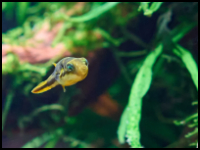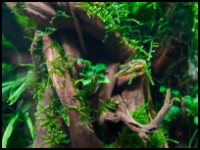





Quick Care Details (Table)
| Livestock Characteristics | Value |
|---|---|
| Care Level | Moderate |
| Temperament | Aggressive |
| Diet | Carnivore |
| Maximum Size | 1.5 Inches |
| Minimum Tank Size | 10 Gallons |
| Plant Safe | Yes |
| Temperature Range | 72-82F |
| PH Range | 7.0-8.0 |
| KH Range | 5-15 |
Species Specific Categories
Helpful Video
Care Details
Aquascape
- Provide plenty of live or artificial plants to create hiding spots for the shy pea puffers.
- Use driftwood, smooth rocks, and small caves to mimic their natural environment and offer additional hiding places.
- Pea puffers appreciate a well-planted aquarium with floating plants to diffuse lighting and create a sense of security.
- Breaking line of sight is important especially if you have more than one pea puffer.
Substrate
- Use a fine-grain substrate to prevent the puffers from accidentally swallowing and choking on large particles.
- A sandy substrate is an excellent choice as it allows the puffers to forage naturally and dig if desired.
Disease Prevention
- Quarantine new pea puffers before introducing them to the main tank to prevent the spread of diseases.
- Maintain good water quality through regular water changes and proper filtration to reduce stress and improve the puffers' overall health.
- Avoid overfeeding, as uneaten food can lead to water quality issues and stress the puffers.
Filtration
- Use a reliable aquarium filter appropriate for the tank size to keep the water clean and free from ammonia and nitrite buildup.
- Consider a sponge filter, which provides gentle water flow and is safe for small puffers that might get sucked into traditional filters.
Lighting
- Provide a moderate lighting level, preferably with dimmable or adjustable lights, as pea puffers can be sensitive to bright light.
- Aim for a natural day-night light cycle, with 8-10 hours of light per day to mimic their natural environment.
Water Flow
- Pea puffers prefer slow to moderate water flow, so avoid strong currents that may stress or exhaust them.
- Position the filter outlet in a way that doesn't create strong currents, or use a sponge pre-filter to reduce flow if necessary.
Temperament and Behavior
Behavior and Social Interaction
- Pea puffers are generally solitary and territorial fish, especially as they mature.
- While they are not schooling fish, they can be kept in small groups that shoal as long as there is enough space and hiding spots for each individual.
- Some individuals may show curiosity towards their owners and become less timid over time with patient and gentle interactions.
Aggression
- Territorial Behavior: Pea puffers are territorial and tend to establish their own space within the aquarium. They can become possessive of certain areas, especially around hiding spots, caves, or plants they consider their territory.
- Intraspecific Aggression: Male pea puffers, in particular, can be aggressive towards each other, especially during breeding times or when competing for territories or mates. Keeping multiple males in the same tank can lead to confrontations and stress.
- Fin Nipping: Pea puffers may exhibit fin-nipping behavior, especially towards slow-moving or long-finned tankmates. They have a beak-like mouth with sharp teeth, which they can use to nip at the fins of other fish.
- Predatory Instinct: Pea puffers are natural predators and may view smaller fish or shrimp as potential food. While some tankmates might be compatible with pea puffers, there's always a risk of them being viewed as prey.
- Feeding Aggression: Pea puffers are opportunistic feeders and can sometimes display aggression during feeding time, especially if there is competition for food.
Breeding
- Breeding pea puffers in captivity can be challenging due to their territorial nature and specific requirements for successful reproduction.
- Provide a separate breeding tank with plenty of hiding spots and live plants to encourage courtship and egg-laying.
- The female will lay small adhesive eggs on plants or tank surfaces, and the male may display courtship behaviors during the process.
- After laying eggs, remove the adult puffers from the breeding tank to prevent them from eating the eggs or fry.
Compatibility
- Pea puffers are not typically community fish and are best kept alone or in small groups with ample hiding spots.
- Avoid keeping them with other small or slow-moving fish that may be mistaken for food or outcompete them for resources.
- They may not be suitable for community tanks with delicate or long-finned fish that might be harassed or nipped by the puffers.
- These fish cannot be kept with slower fish with long fins. They will pester even bigger fish until they die from stress
- They will kill almost any snail on sight if it is on the smaller side. It might pick at bigger snails.
- Crayfish are also not an option due to the fish being able to pick at its eyes and legs.
Activity Level
- Pea puffers are generally active and curious fish, despite their shy tendencies.
- They spend a lot of time exploring their environment, investigating plants, and searching for food.
- Providing ample hiding spots and stimulating their environment with live plants and decorations can encourage their activity and alleviate stress.
- they use all water columns in the home aquarium, but mostly stick to the middle area of the tank.
Group Size
- You can keep them in a large shoal, but group size is important. Having more will spread aggression. This is how aquarium shops can keep them in display fish tanks.
- The best option is to keep only one if a tank when possible.
Diet and Nutrition
Dry Foods
- Pea puffers will generally not accept high-quality dry foods and they should not be the sole diet.
- Some hobbyist suggest they have been able to train their pea puffers to take dry foods even though it is not recommended.
- If you attempt to feed dry foods Look for small-sized pellets or granules suitable for their tiny mouths.
- Choose high-protein dry foods specifically formulated for small carnivorous fish.
Frozen Foods
- Frozen foods are an essential part of a pea puffer's diet.
- Offer a variety of frozen foods like bloodworms, brine shrimp, daphnia, and cyclops. These foods are rich in protein and essential nutrients.
- Thaw the frozen foods before feeding and rinse them to remove any excess nutrients from the packaging.
Live Foods
- Live foods are highly recommended for pea puffers as they mimic their natural diet and stimulate their hunting instincts.
- Small live foods such as live bloodworms, daphnia, brine shrimp, and small snails are excellent choices.
- Raising small snails in a separate breeding tank can provide a continuous supply of live food for your puffers.
Vegetables
- Pea puffers are primarily carnivorous, but they may occasionally nibble on some plant matter in the wild.
- While vegetables are not a significant part of their diet the might bite it out of curiosity.
Algae
- Pea puffers generally will not eat algae.
Feeding Schedule
- Feed pea puffers small portions two to three times a day, as they have a high metabolic rate.
- Offer a mix of frozen and live foods regularly, and supplement with dry foods occasionally.
- Be mindful not to overfeed, as uneaten food can lead to water quality issues.
Tank Parameters
Tank Size
- A minimum tank size of 10 gallons is recommended for a single pea puffer.
- If you plan to keep a pair or a small group, consider a larger tank to provide more space and reduce territorial conflicts.
- Larger tanks offer more stable water conditions and are generally easier to maintain.
Tank Length and Size
- A tank with dimensions around 20 inches (50 cm) in length and 10 inches (25 cm) in width is suitable for a single pea puffer.
- For a pair or small group, consider a tank with dimensions around 30 inches (76 cm) in length and 12-15 inches (30-38 cm) in width.
Water Temperature
- Pea puffers are tropical fish and prefer a stable water temperature between 78-80°F (25-27°C).
- Invest in a reliable aquarium heater to maintain the desired temperature range.
pH (Acidity/Alkalinity)
- Pea puffers prefer slightly acidic to neutral water conditions, ideally with a pH level around 6.5-7.5.
- Regularly monitor the pH level to ensure it stays within the appropriate range.
KH (Carbonate Hardness)
- Maintain a moderate KH level to provide buffering capacity and stabilize the pH.
- Aim for a KH range of 3-8 dKH (degrees of Carbonate Hardness).
GH (General Hardness)
- Pea puffers are adaptable to a range of water hardness levels but prefer moderately soft to slightly hard water.
- Aim for a GH range of 5-12 dGH (degrees of General Hardness).
Hardiness
- Pea puffers are relatively hardy fish, but sudden changes in water conditions can stress them.
- To ensure their well-being, avoid drastic changes in temperature, pH, or water hardness.
Nitrate (NO3) Levels
- Regularly monitor nitrate levels in the tank, as elevated nitrate can harm pea puffers and other fish.
- Aim to keep nitrate levels below 20-30 ppm (parts per million) through regular water changes and proper filtration.
History, Popularity, History and Species Variety Details
Fish Species History
Scientifically known as Carinotetraodon travancoricus, pea puffers are native to the southwestern region of India, specifically found in the Kerala and Karnataka states. They inhabit slow-moving and heavily vegetated waters such as rice paddies, streams, and backwaters. Their natural habitats are often densely vegetated with aquatic plants, providing shelter, hiding places, and hunting grounds. Pea puffers are known to swim among the vegetation and utilize it as camouflage. The natural habitats of pea puffers are under various threats due to habitat degradation, water pollution, and human activities such as agriculture and deforestation. These factors can impact their population numbers in the wild. The introduction of pea puffers to the aquarium hobby is believed to have occurred in the late 20th century. These fish are now captive breed commonly and selectively breed in order to get a richer color and maintain their small size in their gene pool.
Popularity Among Pufferfish Enthusiasts
- Size and Compatibility: Pea puffers are one of the smallest species of pufferfish, reaching an adult size of around 1 inch (2.5 cm). This compact size makes them suitable for small aquariums or nano tanks, which have become increasingly popular among pufferfish enthusiasts with limited space. Additionally, they can be kept with other small, non-aggressive fish species or in a species-only setup.
- Attractive Appearance: Pea puffers are visually striking with their bright colors and intricate patterns. They typically display a mix of green, yellow, brown, and black markings that can vary between individuals. Their round, chubby bodies and large eyes add to their overall charm.
- Unique Behavior: Pea puffers are known for their curious and active nature. They are highly intelligent fish that exhibit intriguing behaviors, such as hunting and manipulating their prey. These puffers have a voracious appetite and are often kept in tanks with snails, as they have a natural inclination to feed on them. This behavior can be entertaining to observe.
- Feeding Challenges: The dietary requirements of pea puffers contribute to their popularity. Unlike many other fish species, they are primarily carnivorous and require a diet rich in protein. Their preference for live or frozen foods, such as snails, worms, and small crustaceans, adds an additional level of engagement for the aquarist.
- Social Media and Online Communities: The rise of social media platforms and online aquarium communities has played a significant role in promoting the popularity of pea puffers. Enthusiasts share their experiences, photos, and videos of their pea puffer tanks, sparking interest among others. The ease of accessing information and connecting with fellow hobbyists has contributed to the growth of pea puffer enthusiasts.
Types of Freshwater Puffers
- Figure Eight Puffer (Tetraodon biocellatus): This pufferfish gets its name from the distinctive black markings on its sides, which resemble the number eight. It's larger than the pea puffer, reaching about 4-5 inches (10-13 cm) in length. Figure Eight Puffers are known for their curious and active personalities.
- Green Spotted Puffer (Tetraodon nigroviridis): Also known as GSP, this pufferfish species has a greenish body with black spots. It can grow up to 6 inches (15 cm) in length and is more commonly kept in brackish water. However, it can adapt to freshwater if acclimated gradually.
- Amazon Puffer (Colomesus asellus): This species is sometimes called the South American Puffer or Asellus Puffer. It has a spiky appearance and reaches around 5-6 inches (13-15 cm) in length. Amazon puffers are found in freshwater and brackish estuaries.
- Red-Eye Puffer (Carinotetraodon lorteti): This species is relatively small, growing up to 1.5 inches (4 cm) in length. It has a bright red-orange eye ring, which gives it its name. Red-Eye Puffers can be kept in freshwater and are known for their inquisitive behavior.
- Mbu Puffer (Tetraodon mbu): The Mbu Puffer is one of the largest freshwater pufferfish species, capable of reaching over 2 feet (60 cm) in length. Due to their enormous size, they require extremely large tanks and are best suited for experienced aquarists.
- Congo Puffer (Tetraodon miurus): This pufferfish species is sometimes mistaken for the pea puffer, but it is a distinct species. It reaches around 2-2.5 inches (5-6 cm) in length and is known for its vibrant coloration and active behavior.
- Arrowhead Puffer (Sphaerichthys vaillanti): Also known as Humpback Puffer or Congo Puffer, this species is unique among pufferfish as it is a true freshwater puffer that inhabits slow-moving blackwater streams in the wild. It reaches around 3 inches (8 cm) in length.
Identification of Males and Females
- Size and Body Shape: In general, female pea puffers tend to be slightly larger and have a rounder or fuller body shape compared to males. However, this difference may not always be easily discernible, especially in younger or smaller individuals. Females will have a much rounder stomach.
- Dorsal Fin: Males may have a slightly elongated or more pointed dorsal fin compared to females, which can be observed when they display during courtship or territorial disputes. However, this distinction may not be apparent during regular swimming or non-display behavior.
- Coloration: While coloration can vary between individuals, especially in different geographical populations and color morphs, some breeders and enthusiasts suggest that males tend to exhibit more intense and vibrant colors. This can include brighter patterns and a more pronounced coloration on their fins and body.
- Behavior: During courtship and breeding, males often display more aggressive and territorial behavior, while females may exhibit more passive or submissive behavior. Males may chase or circle females during courtship, while females may show less aggression or be more receptive to mating.
- Keynote that if the pea puffer is too young these trails will not be pronounced enough to tell the difference. Juveniles will have less color, similar shapes, and less aggression.
Breeding Dwarf Pea Puffers
- Setting up the Breeding Tank:
- Prepare a separate breeding tank. A 10-gallon tank is sufficient for a pair of pea puffers.
- Use soft, slightly acidic water. Maintain a pH level around 6.5-7 and a temperature of 78-80°F (25-27°C).
- Add plenty of hiding places in the form of dense plants, caves, and small, smooth rocks. Live plants like Java moss and floating plants can provide excellent hiding spots and help mimic their natural environment.
- Selecting Healthy Puffer Pairs:
- Choose healthy and active adult pea puffers for breeding. Make sure they are well-fed and disease-free before introducing them into the breeding tank.
- Pea puffers are known to be territorial, so observe them in a separate tank to ensure they are compatible before breeding.
- Conditioning the Puffers:
- Feed the selected pea puffers a varied and nutritious diet, including live and frozen foods. High-quality live or frozen foods like bloodworms, brine shrimp, and daphnia are excellent choices.
- Conditioning the puffers with this nutritious diet will help to enhance their coloration and stimulate breeding behavior.
- Introducing the Puffers:
- Once the puffers are well-conditioned, introduce the male and female into the breeding tank together.
- Monitor their behavior closely. Pea puffers may show aggression during initial introductions, but some level of chasing and posturing is normal during courtship.
- Observing Breeding Behavior:
- Pea puffers exhibit elaborate courtship behaviors, which involve the male displaying his vibrant colors and trying to impress the female.
- The male may follow the female around and display a jerking motion as part of the courtship ritual.
- Egg Laying and Hatching:
- When the female is ready to lay eggs, she will attach them to leaves, plants, or other surfaces in the aquarium. The eggs are tiny and sticky.
- After egg-laying, remove the adult puffers from the breeding tank to prevent them from eating the eggs.
- Raising the Fry:
- The eggs will hatch within a few days. The fry are tiny and delicate, so ensure they have plenty of hiding places and infusoria or baby brine shrimp to feed on initially.
- As they grow, you can transition them to larger live or frozen foods.
- Regular water changes are essential to maintain water quality and keep the fry healthy.
Frequently Asked Questions
Can I keep multiple Dwarf Pea Puffers in one aquarium?
Yes, but you should only ever keep one male Pea Puffer in a group and all the other pea puffers should be females. Also be sure to have a large enough tank equal to the number of puffers you add. The first puffer should have at least 5-gallons and every additional puffer after that should have an additional 2.5-gallons. You should also be sure that you have lots of vegetation and hardscape to break the line of site between the puffers. These fish will shoal in a sense but mostly as a means of spreading aggression.
Will Dwarf Pea Puffers eat aquarium pests?
Yes, they will eat small snails, limpets, planaria, detritus worms, and anchor worms.
Can Pea Puffers live in a 5-gallon aquarium?
Yes, but with a tank that small you should only keep one pea puffer. Keeping water quality good might be a little difficult due to the foods they eat. Be sure to have a good way to export nutrients.
What can I feed my Dwarf Pea Puffer?
They will eat most live foods and frozen foods if they are small enough to fit in their mouth. Great foods would be bloodworms, brine shrimp, mysis, daphnia, or fish eggs. If you feed a Pea Puffer something that is too large, they might pick at it but won’t finish the meal off leaving it to rot. Be careful to siphon out any uneaten food.
Can I have other fish with my Pea Puffer?
Yes, but it can be difficult to find the appropriate tank mates. The key to finding a good tank mate is getting a fish that has short fins and is fast enough to avoid the Dwarf Pea Puffer but isn’t aggressive enough to attack the puffer. Most Tetra, Danio and Rasbora are good candidates to fit this position.
Can Dwarf Pea Puffers puff up?
Yes, though it is rough to notice and doesn’t happen very often. Due to their small size, you might actually miss it puffing up, but when it does it is used as a self defense mechanism against predators. The fish is attempting to make its self-look bigger, more intimidating and making it harder to fit in a fish’s mouth.
Do Pea Puffers need a heater?
Yes, these fish need temperatures between 75-82 degrees Fahrenheit. This is warmer than most households, so you won’t be able to get away with no heater.
Do Dwarf Pea Puffers remember you?
These fish are very smart and have very strong personalities. The fish have been known to watch you as you approach the aquarium and can follow your hand with interest. They will know when their feeding times are ready when you had gets to the top of the aquarium.
Can Pea Puffers Live In Brackishwater
No, they do not do well with any type of saltwater even in low concentrations. Some other puffers do happen to survive in brackish water and some can even live in full marine water conditions.

